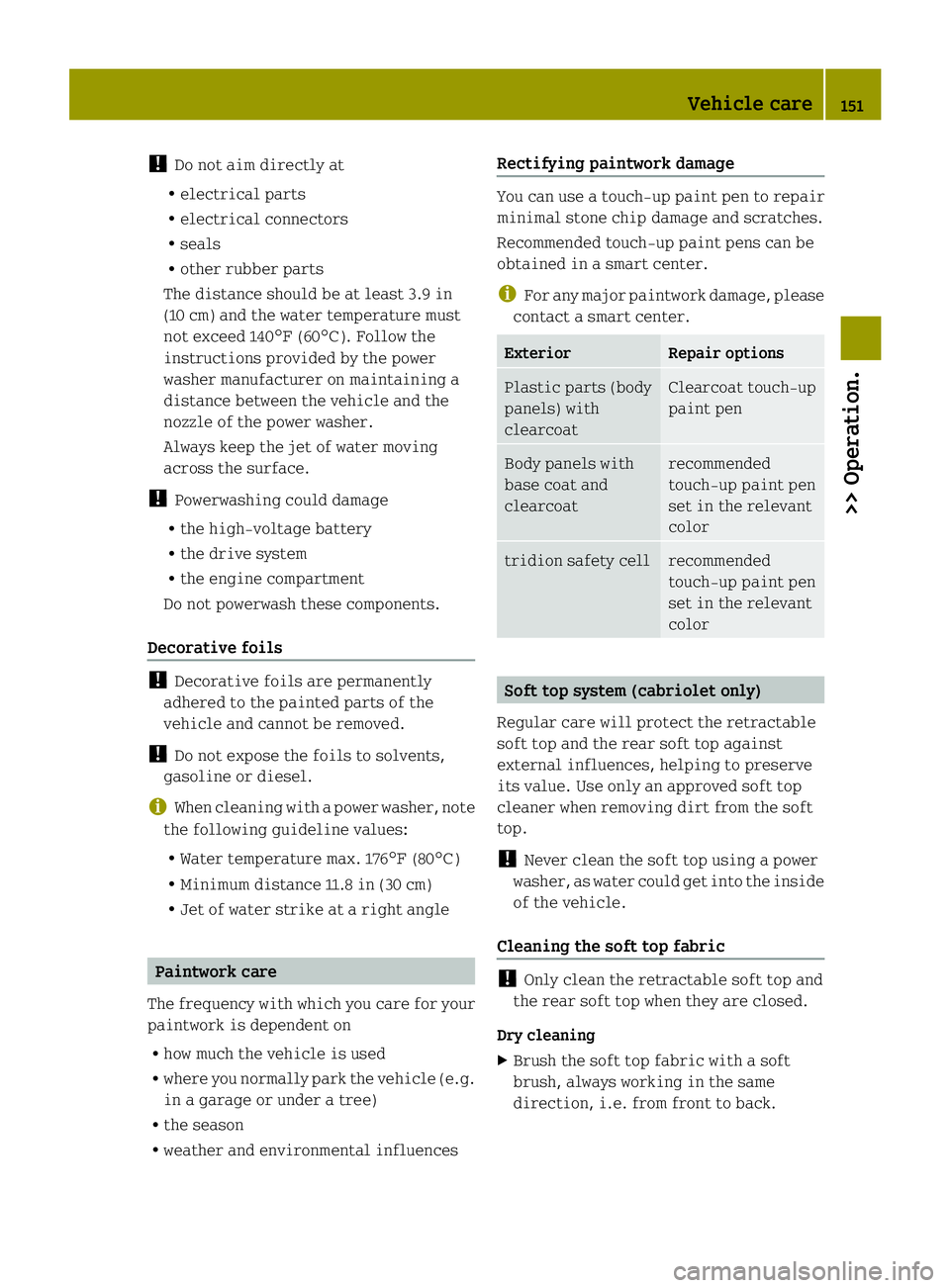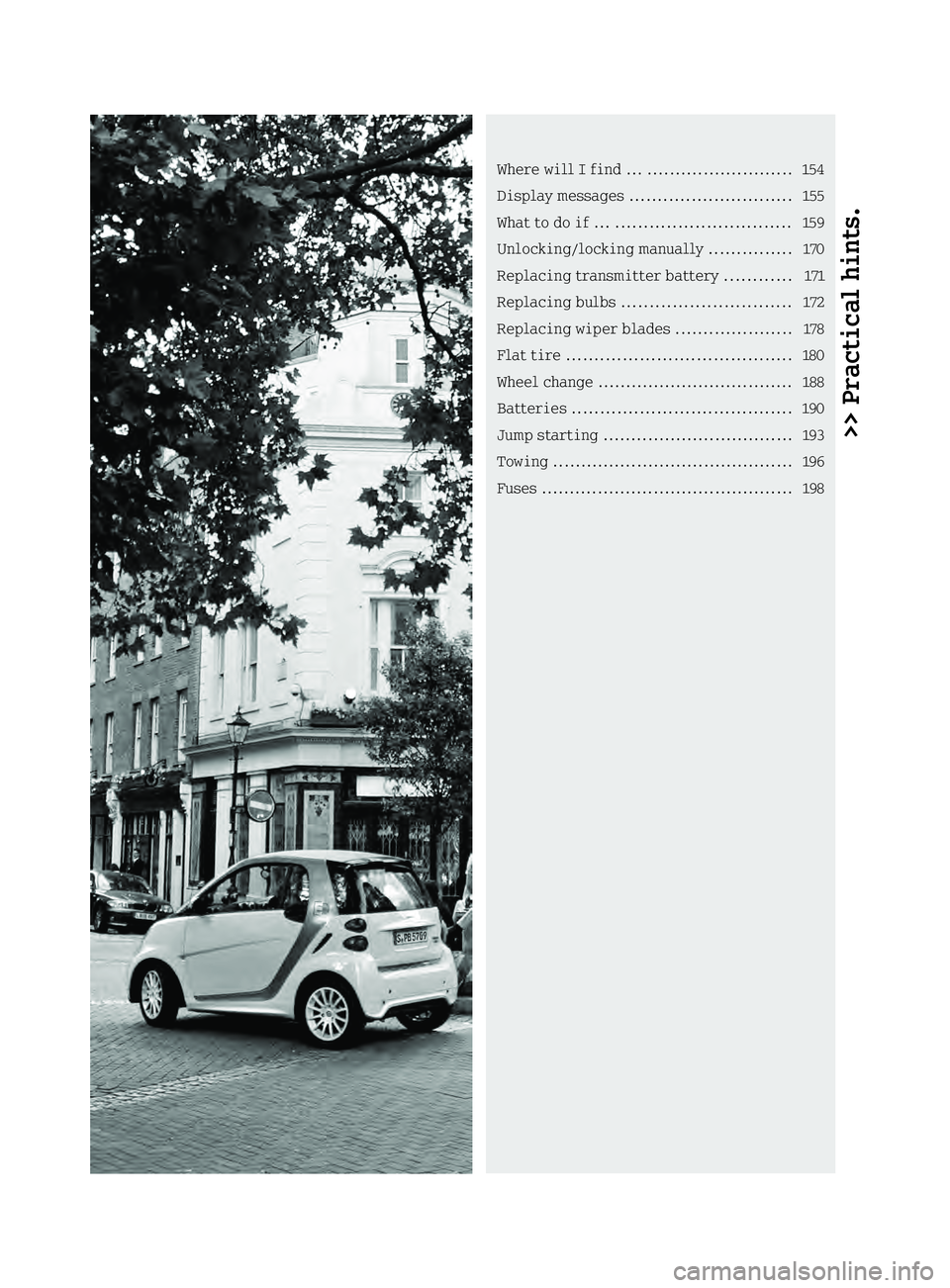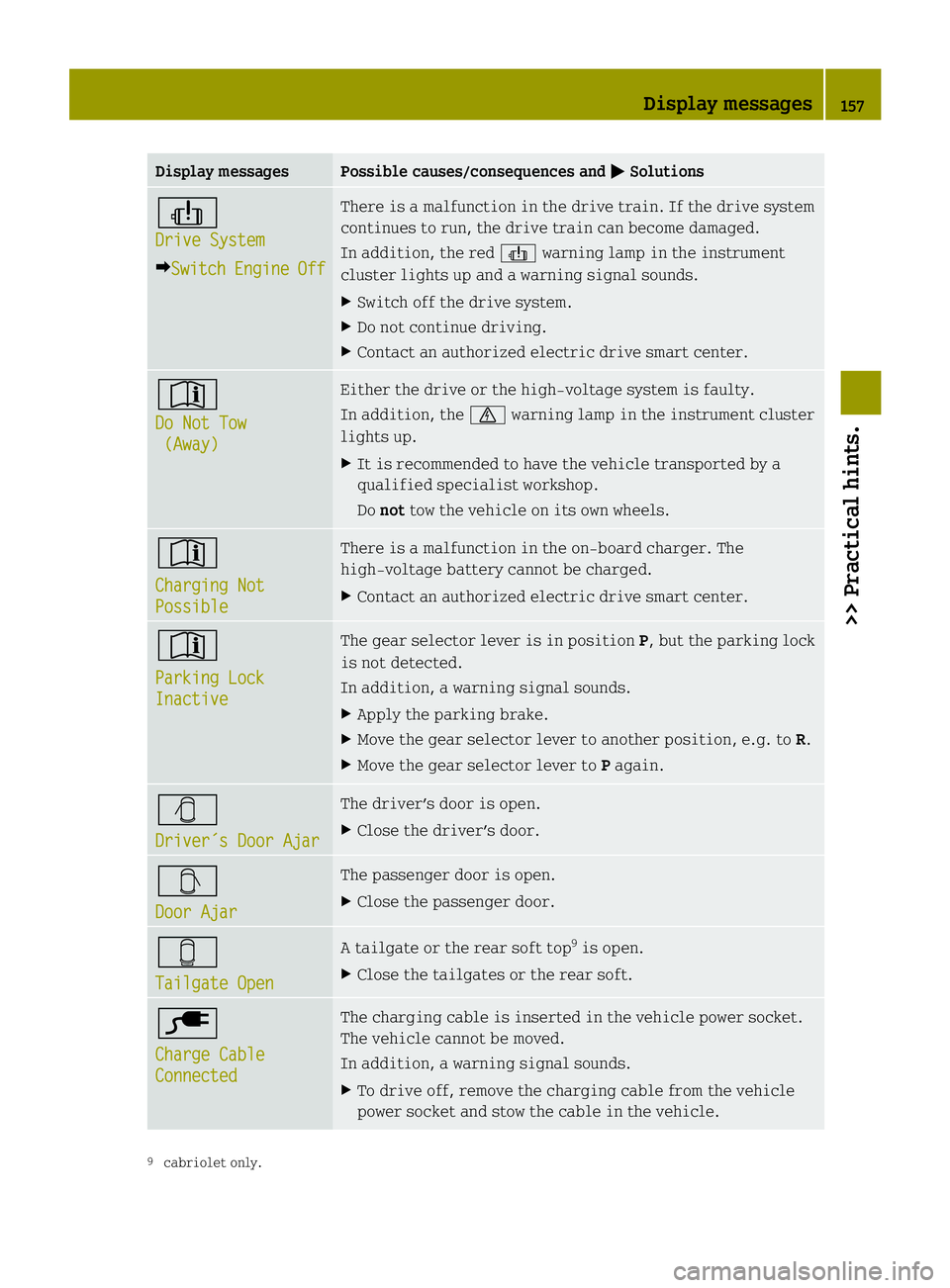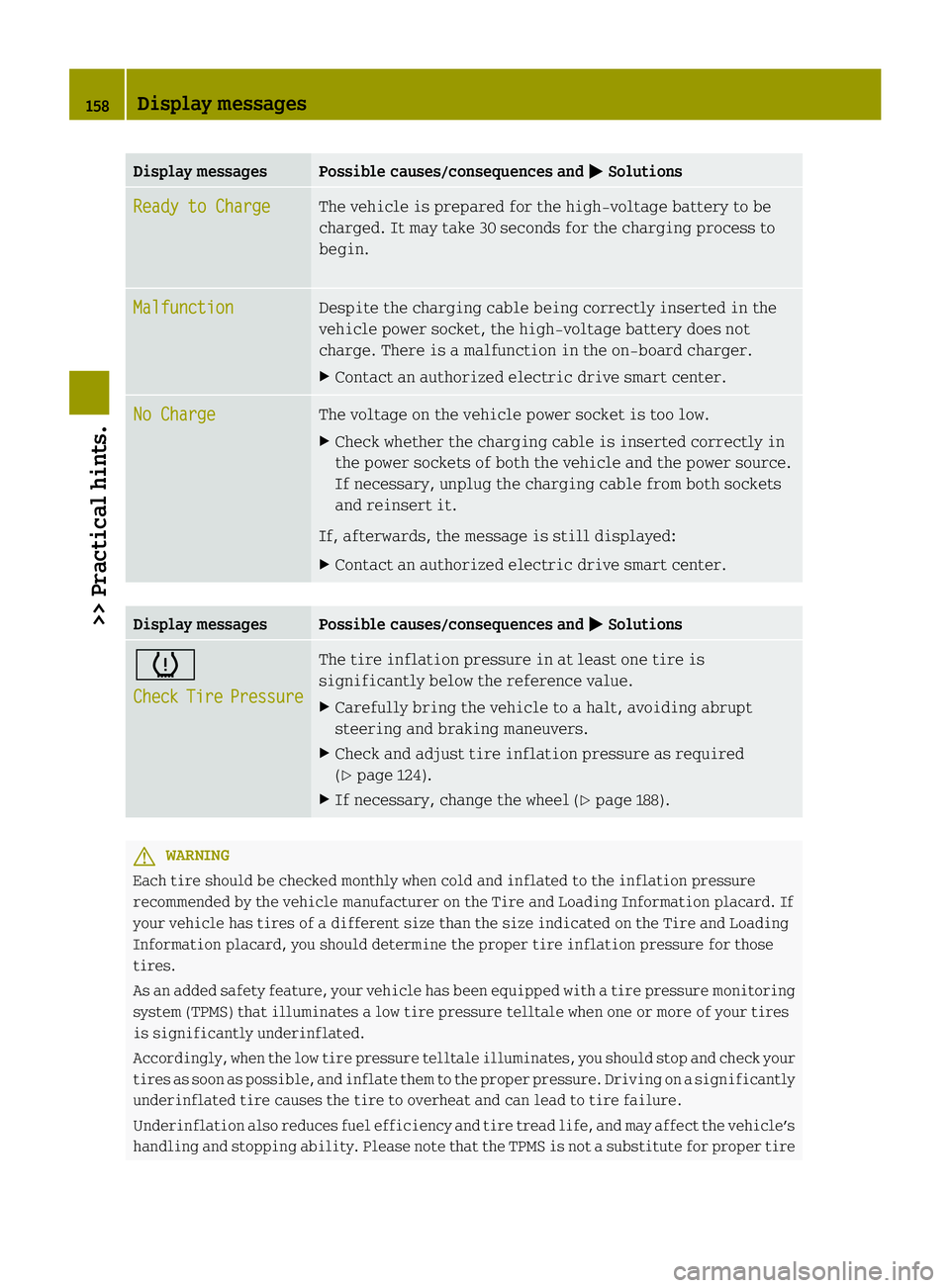2013 SMART FORTWO COUPE ELECTRIC DRIVE battery
[x] Cancel search: batteryPage 141 of 218

Normal occupant weight
The number of occupants the vehicle is
designed to seat, multiplied by
68 kilograms (150 lbs).
Occupant distribution The distributio
nofoccupants in a vehicle
at their designated seating positions.
Production options weight The combined weight of those installed
regular production options weighing over
5 lbs (2.3 kilograms) in excess of those
standard items which they replace, not
previously considered in curb weight or
accessory weight, including heavy duty
brakes, ride levelers, roof rack, heavy duty
battery, and special trim.
PSI (Pounds per square inch) A standard unit of measure for air
pressure.
Recommended tire inflation pressure
The recommended tire inflation pressure
for normal driving conditions is listed on
the Tire and Loading Information placard
located on driver’s door B‑pillar and
provides best handling, tread life and
riding comfort.
Rim Am
etal support for a tire or a tire and tube
assembly upon which the tire beads are
seated.
Sidewall The portion of a tire between the tread and
the bead. TIN (Tire Identification Number) Unique identifier which facilitates
efforts by tire manufacturers to notify
purchasers in recall situations or other
safety matters concerning tires and gives
purchasers the means to easily identify
such tires. The TIN is comprised of
“Manufacturer’s identification mark”,
“Tire size”, “Tire type code” and “Date of
manufacture”.
Tire load rating
Numerical code associated with the
maximum load a tire can support.
Tire ply composition and material used
This indicates the number of plies or the
number of layers of rubber-coated fabric
in the tire tread and sidewall. Tire
manufacturers also must indicate the ply
materials in the tire and sidewall, which
include steel, nylon, polyester, and others.
Tire speed rating
Part of tire designation; indicates the
speed range for which a tire is approved.
Total load limit
Rated cargo and luggage load plus
68 kilograms (150 lbs) times the vehicle’s
designated seating capacity.
Traction
Force exerted by the vehicle on the road via
the tires. The amount of grip provided.
Tread
The portion of a tire that comes into
contact with the road. Tires and wheels
139>> Operation. Z
Page 142 of 218

Treadwear indicators
Narrow bands, sometimes called “wear
bars” that show across the tread of a tire
when only 1
/ 16 in (1.6 mm) of tread remains.
Uniform Tire Quality Grading Standards A tire information system that provides
consumers with ratings for a tire’s
traction, temperature and treadwear.
Ratings are determined by tire
manufacturers using U.S. government
testing procedures. The ratings are molded
into the sidewall of the tire.
Vehicle maximum load on the tire
Load on an individual tire that is
determined by distributing to each axle
its share of the maximum loaded vehicle
weight and dividing it by two.
Winter driving
Before the onset of winter, have your
vehicle winterized at an authorized
electric drive smart center.
This service includes:
R Check of anticorrosion and antifreeze
concentration.
R Addition of washer concentrate to the
water of the windshield/rear window.
Use a windshield washer concentrate
labeled for winter which is formulated
for temperatures below freezing point
(Y page 212).
R 12 V battery test. The capacity of the
12 V battery test drops with decreasing
ambient temperature.
R Tire change. Winter tires
G
WARNING
Winter tires with a tread depth of less
than 1
/ 6 in (4 mm) must be replaced. They
are no longer suitable for winter
operation.
Always use winter tires at temperatures
below 45 ¦(7¥) and whenever wintry road
conditions prevail. Not all M+S rated tires
provide special winter performance. Make
sure the tires you use show the mountain/
snowflake marking 0001on the tire
sidewall. These tires meet specific snow
traction performance requirements of the
Rubber Manufacturers Association (RMA)
and the Rubber Association of Canada (RAC)
and have been designed specifically for
use in snow conditions. Use of winter tires
is the only way to achieve the maximum
effectiveness of the ABS and ESP ®
in winter
operation.
For safe handling, make sure all mounted
winter tires are of the same make and have
the same tread design.
For information on winter tires for your
vehicle model, see the "Technical data"
section (Y page 210).
Always observe the speed rating of the
winter tires installed on your vehicle. If
the maximum speed for which your tires are
rated is below the speed rating of your
vehicle, you must place a notice to this
effect where it will be seen by the driver.
Such notices are available at your tire
dealer or any authorized electric drive
smart center. Snow chains*
! Remember that snow chains must always
be compatible with the tire sizes of a
vehicle. Snow chains that are approved
by smart are only permitted for the
following tire size: 140
Winter driving>> Operation.
* optional
Page 148 of 218

!
Water in these areas could cause
damage to
R electrical components
R electrical wiring
R the drive system
R the high-voltage battery
Any such damage is not covered by the
smart Limited Warranty. Passenger compartment
G
WARNING
Always fasten items being carried as
securely as possible.
In an accident, during hard braking or
sudden maneuvers, loose items thrown
around inside the vehicle may injure
vehicle occupants.
The cargo compartment is the preferred
place to carry objects. Control and operation of radio
transmitters
Radio and telephone G
WARNING
Please do not forget that your primary
responsibility is to drive the vehicle
safely. Only operate the radio or
telephone 8
if road, weather and traffic
conditions permit.
Bear in mind that at a speed of just 30 mph
(approximately 50 km/h), your vehicle is
covering adistance of 44 feet
(approximately 14 m) every second.
Telephones and two-way radios G
WARNING
Never operate radio transmitters equipped
with a built-in or attached antenna (i.e.
without being connected to an external antenna) from inside the vehicle while the
drive system is switched on. Doing so could
lead to a malfunction of the vehicle’s
electronic system, possibly resulting in an
accident and/or serious personal injury.
Radio transmitters, such as a mobile phone
or a citizens band unit should only be used
inside the vehicle if they are connected to
an antenna that is installed on the outside
of the vehicle.
Refer to the radio transmitter operation
instructions regarding use of an external
antenna. Coolant temperature
During severe operating conditions and
stop-and-go city traffic, the coolant
temperature may rise.
! Excessive coolant temperature causes
the red coolant temperature warning
lamp 0005 in the instrument cluster to
come on.
The drive system should not be operated
with the red coolant temperature
warning lamp 0005illuminated. Doing
so may cause serious damage to the drive
system and the high-voltage battery,
which is not covered by the smart Limited
Warranty.
For more information on coolant
temperature warning lamp ( Ypage 165). Driving abroad
Abroad, there is an extensive smart service
network at your disposal. If you plan to
drive into areas which are not listed in the
index of your smart center directory, you
should request pertinent information from
an authorized electric drive smart center.
8 Observe all legal requirements. 146
Driving abroad>> Operation.
Page 153 of 218

!
Do not aim directly at
R electrical parts
R electrical connectors
R seals
R other rubber parts
The distance should be at least 3.9 in
(10 cm) and the water temperature must
not exceed 140¦ (60¥). Follow the
instructions provided by the power
washer manufacturer on maintaining a
distance between the vehicle and the
nozzle of the power washer.
Always keep the jet of water moving
across the surface.
! Powerwashing could damage
R the high-voltage battery
R the drive system
R the engine compartment
Do not powerwash these components.
Decorative foils !
Decorative foils are permanently
adhered to the painted parts of the
vehicle and cannot be removed.
! Do not expose the foils to solvents,
gasoline or diesel.
i When cleaning with apower washer, note
the following guideline values:
R Water temperature max. 176 ¦(80¥)
R Minimum distance 11.8 in (30 cm)
R Jet of water strike at a right angle Paintwork care
The frequency with which you care for your
paintwork is dependent on
R how much the vehicle is used
R where you normally park the vehicle (e.g.
in a garage or under a tree)
R the season
R weather and environmental influences Rectifying paintwork damage You can use a touch-up paint pen to repair
minimal stone chip damage and scratches.
Recommended touch-up paint pens can be
obtained in a smart center.
i
For any major paintwork damage, please
contact a smart center. Exterior Repair options
Plastic parts (body
panels) with
clearcoat Clearcoat touch-up
paint pen
Body panels with
base coat and
clearcoat recommended
touch-up paint pen
set in the relevant
color
tridion safety cell recommended
touch-up paint pen
set in the relevant
color
Soft top system (cabriolet only)
Regular care will protect the retractable
soft top and the rear soft top against
external influences, helping to preserve
its value. Use only an approved soft top
cleaner when removing dirt from the soft
top.
! Never clean the soft top using a power
washer, as water could get into the inside
of the vehicle.
Cleaning the soft top fabric !
Only clean the retractable soft top and
the rear soft top when they are closed.
Dry cleaning
X Brush the soft top fabric with a soft
brush, always working in the same
direction, i.e. from front to back. Vehicle care
151>> Operation. Z
Page 155 of 218

>> Practical hints.Where will
Ifind ... .......................... 154
Display messages ............................. 155
What to do if ... ............................... 159
Unlocking/locking manually ...............170
Replacing transmitter battery ............171
Replacing bulbs .............................. 172
Replacing wiper blade s..................... 178
Flat tire ........................................ 180
Wheel change ................................... 188
Batteries ....................................... 190
Jump starting .................................. 193
Towing ........................................... 196
Fuses ............................................. 198
Page 158 of 218

Display messages Possible causes/consequences and
0001 Solutions
0001
Malfunction Serv.
Req. There is a malfunction in the coolant compressor or in the
heating/coolant circuit.
X
Contact an authorized electric drive smart center. 0001
Battery Power Too
Low The outside temperature is too low. The full battery capacity
is not available.
The vehicle does not start.
X
Charge the high‑voltage battery (Y page 108).0001
High-voltage
Battery at Reserve
Level The high‑voltage battery has reached reserve level.
X
Charge the high‑voltage battery (Y page 108).0007
Charge HV Battery
Immediately The charge level of the high‑voltage battery is below 5 %.
In addition, a warning signal sounds.
X
Charge the high‑voltage battery (Y page 108).0002
Engine
Restart Not
Possible There is a serious malfunction in the drive system. The drive
system can no longer be started.
In addition, a warning signal sounds.
X
Do not restart the drive system.
X Contact an authorized electric drive smart center. 0002
High-Voltage
System
0001Service Required There is a malfunction in the drive system, the electric motor
or the high‑voltage battery. There is a high‑voltage safety
problem.
In addition, the
0002warning lamp in the instrument cluster
lights up and a warning signal sounds.
X Contact an authorized electric drive smart center. 0001
Drive System
0001Service Required There is a malfunction in the drive system, the electric motor
or the high‑voltage battery.
In addition, the yellow
0001warning lamp in the instrument
cluster lights up.
X Contact an authorized electric drive smart center. 156
Display messages>> Practical hints.
Page 159 of 218

Display messages Possible causes/consequences and
0001 Solutions
0001
Drive System
0001Switch Engine Off There is a malfunction in the drive train. If the drive system
continues to run, the drive train can become damaged.
In addition, the red 0001warning lamp in the instrument
cluster lights up and a warning signal sounds.
X Switch off the drive system.
X Do not continue driving.
X Contact an authorized electric drive smart center. 0007
Do Not Tow
(Away) Either the drive or the high‑voltage system is faulty.
In addition, the
0002warning lamp in the instrument cluster
lights up.
X It is recommended to have the vehicle transported by a
qualified specialist workshop.
Do not tow the vehicle on its own wheels. 0007
Charging Not
Possible There is a malfunction in the on-board charger. The
high‑voltage battery cannot be charged.
X
Contact an authorized electric drive smart center. 0007
Parking Lock
Inactive The gear selector lever is in position
P, but the parking lock
is not detected.
In addition, a warning signal sounds.
X Apply the parking brake.
X Move the gear selector lever to another position, e.g. to R.
X Move the gear selector lever to Pagain. 0001
Driver´s Door Ajar The driver’s door is open.
X
Close the driver’s door. 0002
Door Ajar The passenger door is open.
X
Close the passenger door. 0003
Tailgate Open A tailgate or the rear soft top
9
is open.
X Close the tailgates or the rear soft. 0003
Charge Cable
Connected The charging cable is inserted in the vehicle power socket.
The vehicle cannot be moved.
In addition, a warning signal sounds.
X
To drive off, remove the charging cable from the vehicle
power socket and stow the cable in the vehicle. 9
cabriolet only. Display messages
157>> Practical hints. Z
Page 160 of 218

Display messages Possible causes/consequences and
0001 Solutions
Ready to Charge The vehicle is prepared for the high‑voltage battery to be
charged. It may take 30 seconds for the charging process to
begin.
Malfunction Despite the charging cable being correctly inserted in the
vehicle power socket, the high‑voltage battery does not
charge. There is a malfunction in the on-board charger.
X
Contact an authorized electric drive smart center. No Charge The voltage on the vehicle power socket is too low.
X
Check whether the charging cable is inserted correctly in
the power sockets of both the vehicle and the power source.
If necessary, unplug the charging cable from both sockets
and reinsert it.
If, afterwards, the message is still displayed:
X Contact an authorized electric drive smart center. Display messages Possible causes/consequences and
0001 Solutions
0008
Check
Tire Pressure The tire inflation pressure in at least one tire is
significantly below the reference value.
X
Carefully bring the vehicle to a halt, avoiding abrupt
steering and braking maneuvers.
X Check and adjust tire inflation pressure as required
(Y page 124).
X If necessary, change the wheel (Y page 188).G
WARNING
Each tire should be checked monthly when cold and inflated to the inflation pressure
recommended by the vehicle manufacturer on the Tire and Loading Information placard. If
your vehicle has tires of a different size than the size indicated on the Tire and Loading
Information placard, you should determine the proper tire inflation pressure for those
tires.
As an adde dsafety feature, your vehicle has been equipped with a tire pressure monitoring
system (TPMS) that illuminates a low tire pressure telltale when one or more of your tires
is significantly underinflated.
Accordingly, when the low tire pressure telltale illuminates, you should stop and check your
tires as soon as possible, and inflate them to the proper pressure. Driving on a significantly
underinflated tire causes the tire to overheat and can lead to tire failure.
Underinflation also reduces fuel efficiency and tire tread life, and may affect the vehicle’s
handlin gand stopping ability. Pleas enote that the TPMS is not a substitute for proper tire 158
Display messages>> Practical hints.